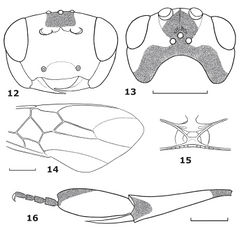Hartemita coffeana
| Notice: | This page is derived from the original publication listed below, whose author(s) should always be credited. Further contributors may edit and improve the content of this page and, consequently, need to be credited as well (see page history). Any assessment of factual correctness requires a careful review of the original article as well as of subsequent contributions.
If you are uncertain whether your planned contribution is correct or not, we suggest that you use the associated discussion page instead of editing the page directly. This page should be cited as follows (rationale):
Citation formats to copy and paste
BibTeX: @article{Long2011ZooKeys102, RIS/ Endnote: TY - JOUR Wikipedia/ Citizendium: <ref name="Long2011ZooKeys102">{{Citation See also the citation download page at the journal. |
Ordo: Hymenoptera
Familia: Braconidae
Genus: Hartemita
Name
Hartemita coffeana Long & van Achterberg, 2011 sp. n. – Wikispecies link – ZooBank link – Pensoft Profile
Type material
Holotype, female (IEBR), “Card.059”, “[S Vietnam:] Dak Lak, Easo, coffee farm, MT, 108°37’E, 02.vii.2008, Ngo Hien”.
Diagnosis
The new species is close to Hartemita rhadinotarsa Dangerfield & Austin, but differs by having epistomal suture indistinctly developed, with the rugosities of the face and the punctures of the clypeus distinct (suture distinct and face and clypeus finely punctate in Hartemita rhadinotarsa); the occiput deeply concave (moderately concave in Hartemita rhadinotarsa); the hind tarsal segments (excerpt basitarsus) 0.6 times as long as hind basitarsus (0.8 times in Hartemita rhadinotarsa) and the hind tarsal claws with 5 teeth (2–4 teeth in Hartemita rhadinotarsa). Differs from Hartemita excavata Chen, He & Ma by having the transverse diameter of the eye in dorsal view 1.3 times as long as the temple (0.9 times in Hartemita excavata), POL 1.5 times OD (1.3 times in Hartemita excavata) and the scutellar sulcus with 5 cross-carinae (3 cross-carinae in Hartemita excavata).
Description
Holotype, female, body length 6.2 mm, fore wing length 7.3 mm, antenna 7.8 mm.
Head. Antennal segments 52; third segment 1.2 times as long as fourth segment; length of third, fourth and penultimate segments 2.3, 1.9 and 2.0 times their width, respectively; head width 2.2 times its median length; occiput deeply excavate (Fig. 13); temple behind eyes convex anteriorly, gradually narrowed posteriorly (Fig. 13); length of temple 0.9 times transverse diameter of eye; OOL:POL:OD = 19:9:6; frons wide and with a median carina (Fig. 13); eye glabrous, width of face 1.5 times height of eye; clypeal margin nearly straight medially, epistomal suture indistinct; malar space 1.4 times width of mandible; face largely rugose; clypeus shiny and punctate; temple very shiny and with sparse but large and discrete punctures, distance between punctures twice diameter of puncture; frons smooth laterally, striate medially and transversely rugose posteriorly.
Mesosoma. Length of mesosoma 1.1 times its height; pronotal trough sparsely crenulate medially, remainder of pronotal side sparsely punctate; propleuron sparsely punctate; notauli flattened posteriorly, narrowed anteriorly and crenulate; scutellar sulcus with 5 cross-carinae; scutellum convex, punctate; median arch of metanotum with lateral cross-carinae (Fig. 15); mesopleuron shiny, medially with sparse punctures and rugose-punctate anteriorly; precoxal sulcus crenulate anteriorly and rugose posteriorly; mesosternum areolate-punctate; metapleuron and propodeum rugose.
Wings. Length of fore wing 2.9 times its maximum width; length of pterostigma 4.0 times its median width; r:2-SR:3-SR = 18:20:40; second submarginal cell of fore wing 3.4 times longer than its maximum width (Fig. 14); vein 1-CU1 0.4 times as long as vein 2-CU1; vein 3-SR joining SR1 at 100°. Length of hind wing 4.3 times its width; vein M+CU 0.4 times as long as vein 1-M.
Legs. Length of hind femur 4.2 times its width; length of hind tibia 4.4 times its apical width; hind basitarsus slightly produced apically (Fig. 16), flattened, not broadly laminate, 2.8 times longer than wide and as wide as apical width of hind tibia (Fig. 16);second-fifthhind tarsal segments 0.6 times as long as hind basitarsus; inner hind tibial spur 0.6 times as long as hind basitarsus; hind tarsal claw with 5 teeth; hind coxa and outer side of hind femur rugose-punctate; upper side of hind tibia with some spines.
Metasoma. Second metasomal tergite 0.8 times as long as third tergite; ovipositor sheath short; ovipositor curved.
Colour. Body yellow; scapus yellow, black apically and laterally; frons black medially, yellow laterally; stemmaticum and vertex black; temple black along occiput margin; hind femur yellow with black band on upper side; hind tibia yellow, black basally and apically; hind basitarsus yellow, black apically; hind spurs and tarsus (except basitarsus) dark brown.
Male. Unknown.
Distribution
S Vietnam: Dak Lak.
Etymology
After the genus Coffea Linnaeus, because the new species was collected at a coffee farm.
Original Description
- Long, K; van Achterberg, C; 2011: Review of the genus Hartemita Cameron, 1910 (Hymenoptera, Braconidae, Cardiochilinae), with the description of six new species from Vietnam ZooKeys, 102: 19-46. doi
Images
|
